1996 BUICK PARK AVENUE inflation pressure
[x] Cancel search: inflation pressurePage 202 of 388
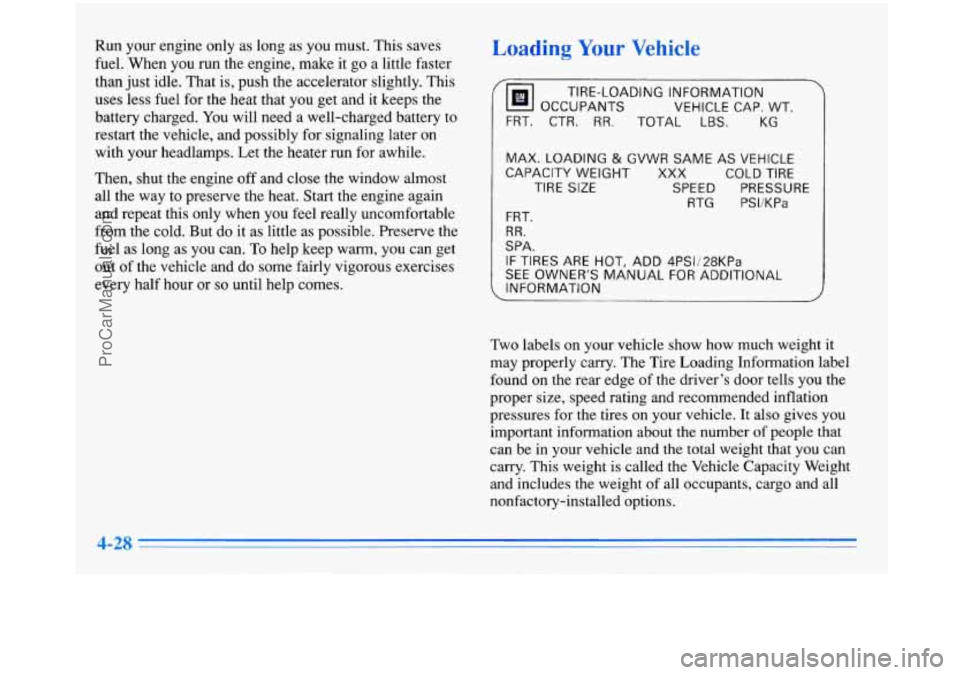
Run your engine only as long as you must. This saves
fuel. When you run the engine, make it go a little faster
than just idle. That is, push the accelerator slightly. This
uses less fuel for the heat that you get and it keeps the
battery charged. You will need a well-charged battery to
restart the vehicle, and possibly for signaling later on
with your headlamps. Let the heater run for awhile.
Then, shut the engine off and close the window almost
all the way to preserve the heat. Start the engine again
and repeat this only when you feel really uncomfortable
from the cold. But do it as little as possible. Preserve the
fuel as long as you can. To help keep warm, you can get
out of the vehicle and do some fairly vigorous exercises
every half hour or
so until help comes.
Loading Your Vehicle
ym OCCUPANTS
VEHICLE CAP. WT.
TIRE-LOADING INFORMATION
7
FRT. CTR. RR. TOTAL LBS. KG
MAX. LOADING & GVWR
SAME AS VEHICLE
CAPACITY WEIGHT XXX COLD TIRE
TIRE
SIZE SPEED PRESSURE
RTG PSI/KPa
FRT.
RR.
SPA.
IF TIRES ARE HOT, ADD 4PSIi28KPa
SEE OWNER'S MANUAL FOR ADDITIONAL
INFORMATION
- ~ ~ __
Two labels on your vehicle show how much weight it
may properly carry. The Tire Loading Information label
found on the rear edge
of the driver's door tells you the
proper size, speed rating and recommended inflation
pressures for the tires on your vehicle. It also gives you
important information about the number
of people that
can be in your vehicle and the total weight that you can
carry. This weight is called the Vehicle Capacity Weight
and includes the weight of all occupants, cargo and all
nonfactory-installed options.
4-28
ProCarManuals.com
Page 246 of 388
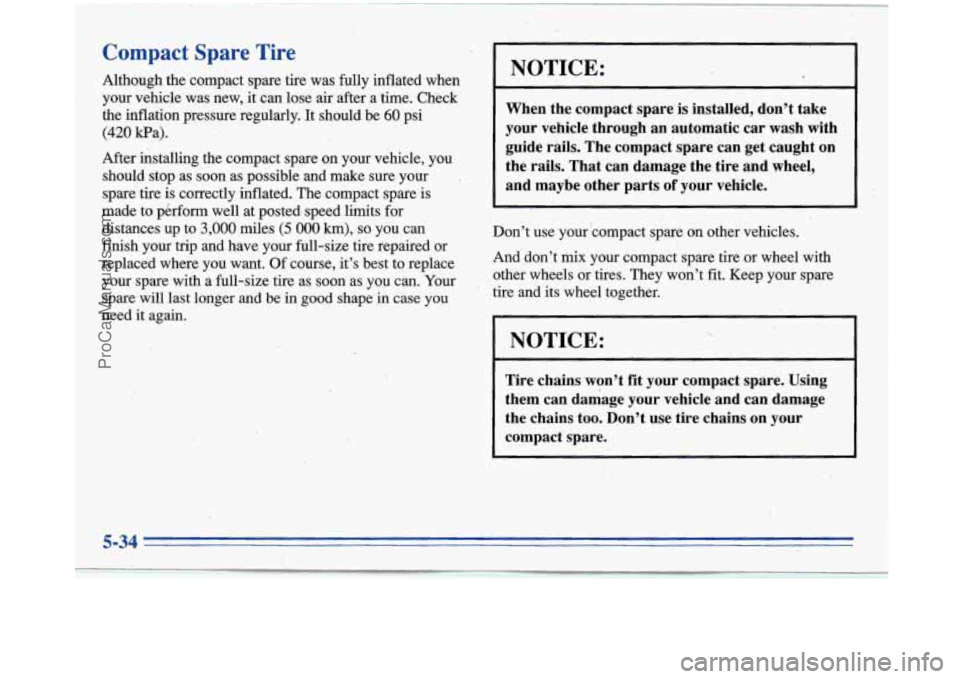
Compact Spare Tire,
Although the compact spare tire was fully inflated when
yoq vehicle was new, it can lose air after a time. Check
the inflation pressure regularly. It should be
60 psi
(420 Pa).
After installing the compact spare on your vehicle, you
should stop as
soon as possible and make sure your .
spare tire is corre,ctly inflated. The compact spare is
made to perform well at posted, speed limits for’
distances
up to 3,000 miles (5 000 km), so you can
finish your trip and have your full-size tire repaired or
replaced where you want.
Of course, it’s best to replace
your spare with a full-size tire as soon as you can. Your
spare,will last longer and be’
in good shape @ case you
need
it again.
NOTICE:
When the compact spare is installed, don’t take
your vehicle through an automatic car wash with
guide rails. The compact spare can get caught on
the rails. That can damage the tire and wheel,
and maybe other parts
of your vehicle.
Don’t use your ‘compact spare on other vehicles.
And don’t mix your compact spare tire
or wheel with
other wheels or tires. They won’t
fit. Keep your spare
tire and its wheel together.
NOTICE: *
Tire chains won’t fit your compact spare. Using
them can damage your vehicle and can damage
the chainstoo. Don’t use tire chains on your
compact spare.
5-34 ~-
ProCarManuals.com
Page 288 of 388
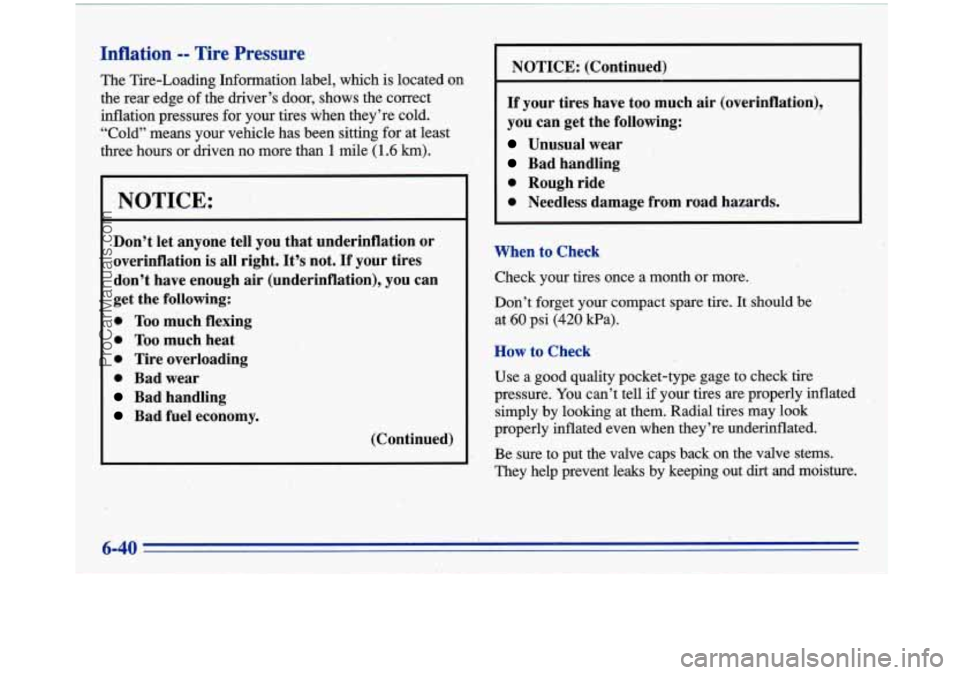
Inflation -- Tire Pressure
The Tire-Loading Information label, which is located on
the rear edge
of the driver’s door, shows the correct
inflation pressures for your tires when they’re cold.
“Cold” means your vehicle has been sittkg for at least
three hours or driven no more than
1 mile (1.6 km).
.NOTICE:
Don’t let anyone tell you that underinflation or
overinflation is all right. It’s not.
If your tires
don’t have enough air (underinflation), you can
get the following:
0 Too much flexing
0 Too much heat
0 Tire overloading
0 Bad wear
Bad handling
Bad fuel economy.
I
(Continued) NOTICE: (Continued)
If your tires have too much air (overinflation),
you can get the following:
Unusual wear
Bad handling
0 Rough ride
0 Needless damage from road hazards.
When to Check Check your tires once a month or more.
Don’t forget your compact spare tire. It should be
at
60 psi (420 Ea).
How to Check
Use a good quality pocket-type gage to check tire
pressure.
You can’t tell if your tires are properly inflated
simply by looking at them. Radial tires may look
properly inflated even when they’re underinflated.
Be sure to put the valve caps back on the valve stems.
They help prevent leaks by keeping out dik and moisture.
6-40
,
ProCarManuals.com
Page 289 of 388
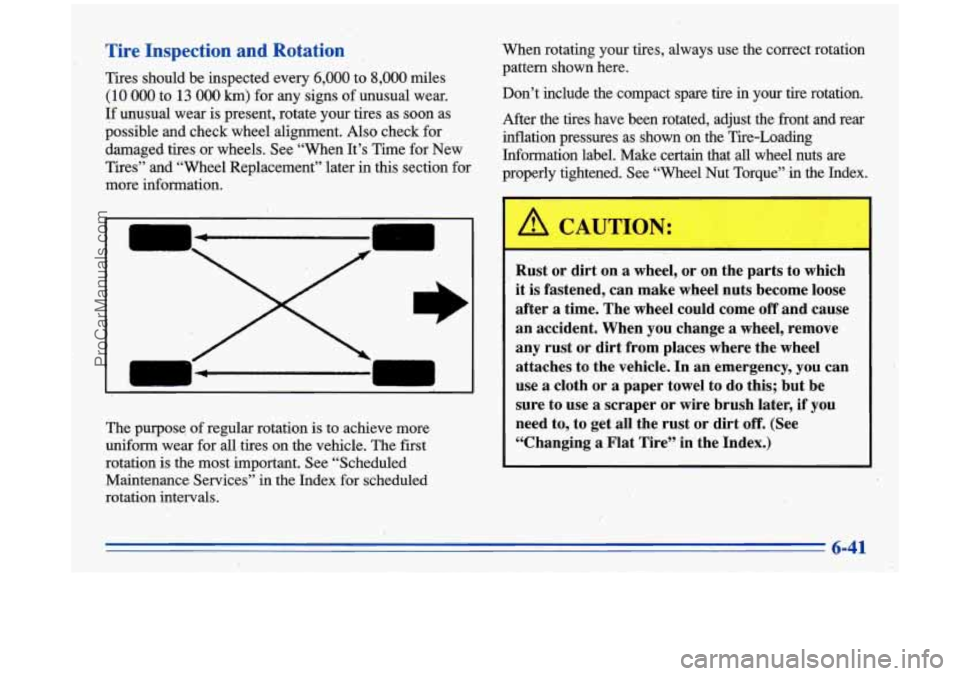
Tire Inspection and Rotation ,
Tires should be inspected every 6,000 to 8,000 miles
(10 000 to 13 000 km) for any signs of unusual wear.
If unusual wear is present, rotate yourtires as soon as
possible and check wheel alignment.
Also check for
damaged tires or wheels. See “When It’s The for New
Tires” and “Wheel Replacement” later in this section for
more information. When
rotating your tires, always use the correct rotation
pattern shown here.
Don’t include the compact spare tire in your tire rotation.
After the tires have been rotated, adjust the front and rear
inflation pressures as shown on the Tire-Loading
Information label. Make certain that
all wheel nuts are
properly tightened. See “Wheel Nut Torque”
in the Index.
I I
The purpose of regular rotation is to achieve more
uniform wear for
all tires on the vehicle. The first
rotation is the most important. See “Scheduled
Maintenance Services”
in the Index for scheduled
rotation intervals.
A CAUTION:
I
Rust or dirt on a wheel, or on the parts to which
it
is fastened, can make wheel nuts become loose
after
a time. The wheel could come off and cause
an accident. When
you change a wheel, remove
any rust or dirt from places where the wheel
attaches
to the vehicle. In an emergency, you can
use
a cloth or a paper towel to do this; but be
sure to use a scraper or wire brush later, if you
need to, to get all the rust
or dirt off. (See
“Changing
a Flat Tire” in the Index.)
6-41
ProCarManuals.com
Page 312 of 388
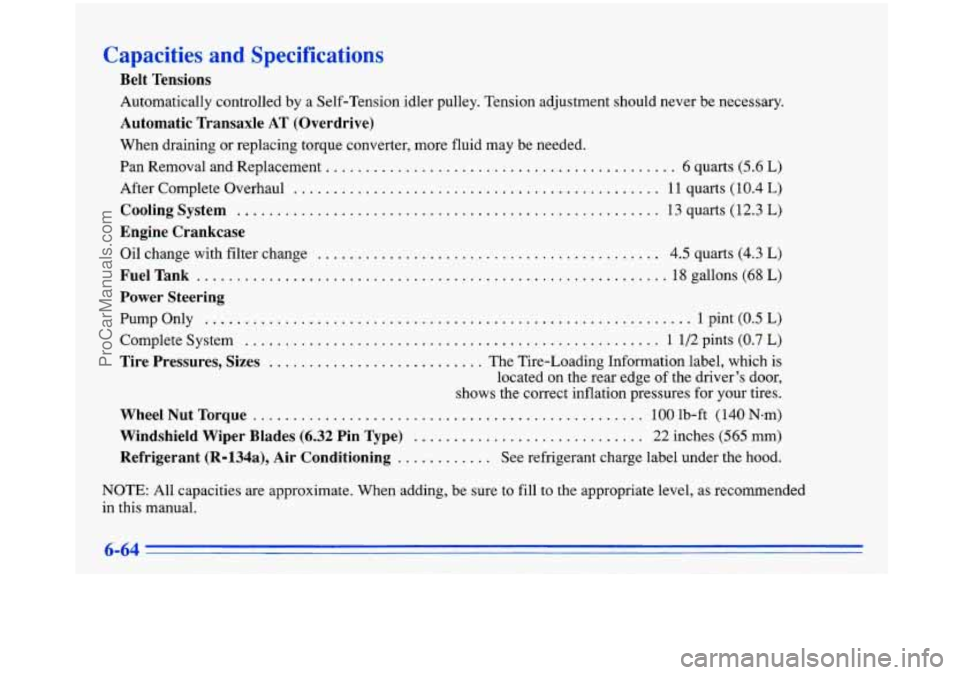
Capacities and Specifications
Belt Tensions
Automatically controlled by a Self-Tension idler pulley. Tension adjustment should never be necessary.
Automatic Transaxle AT (Overdrive)
When draining or replacing torque converter, more fluid may be needed.
Pan Removal and Replacement
............................................ 6 quarts (5.6 L)
After Complete Overhaul .............................................. 11 quarts (1 0.4 L)
Cooling System ..................................................... 13 quarts (12.3 L)
Oil change with filter change ........................................... 4.5 quarts (4.3 L)
Engine Crankcase
FuelTank
........................................................... 18gallons(68L)
Power Steering
Pump Only ............................................................. 1 pint (0.5 L)
Complete System .................................................... 1 1/2 pints (0.7 L)
Tire Pressures, Sizes ........................... The Tire-Loading Information label, which is
located on the rear edge of the driver’s door,
shows the correct inflation pressures for your tires.
Wheel Nut Torque ................................................. 100 lb-ft (140 N-rn)
Windshield Wiper Blades (6.32 Pin Type) ............................. 22 inches (565 mm)
Refrigerant (R=134a), Air Conditioning ............ See refrigerant charge label under the hood.
NOTE: All capacities are approximate. When adding, be sure to fill to the appropriate level, as recommended
in this manual.
6-64
ProCarManuals.com
Page 356 of 388
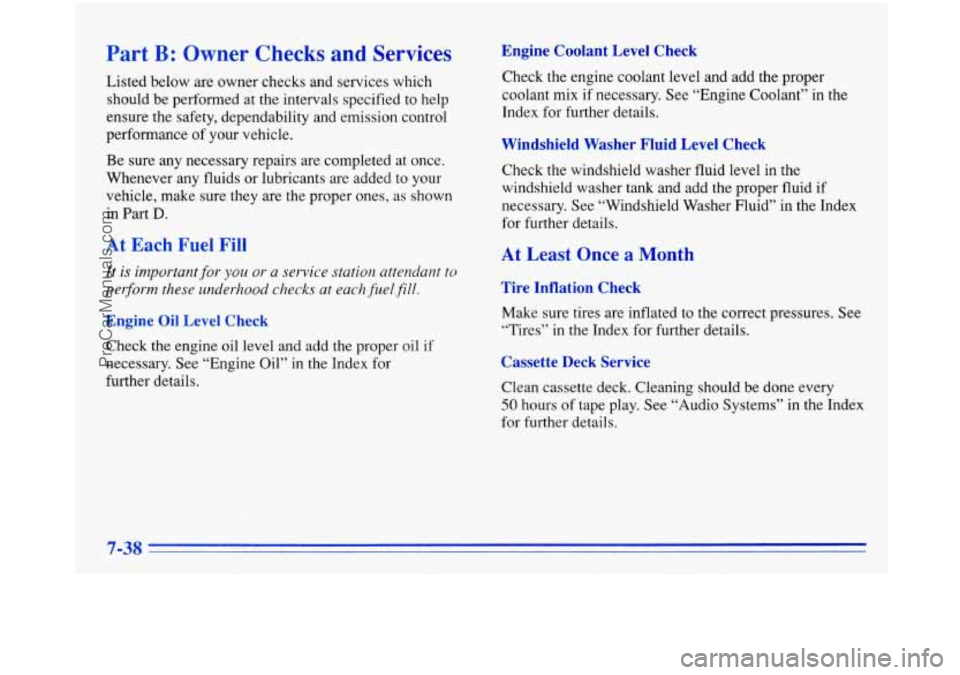
Part B: Owner Checks and Services
Listed below are owner checks and services which
should be performed at the intervals specified to help
ensure the safety, dependability and emission control
performance of your vehicle.
Be sure any necessary repairs are completed at once.
Whenever any fluids or lubricants are added to your
vehicle, make sure they are the proper ones,
as shown
in
Part D.
At Each Fuel Fill
It is important for you or a service station attendant to
perform these underhood checks at each
fuel fill.
Engine Oil Level Check
Check the engine oil level and add the proper oil if
necessary. See “Engine Oil” in the Index for
further details.
Engine Coolant Level Check
Check the engine coolant level and add the proper
coolant mix if necessary. See “Engine Coolant” in the
Index for further details.
Windshield Washer Fluid Level Check
Check the windshield washer fluid level in the
windshield washer tank and add the proper fluid if
necessary. See “Windshield Washer Fluid” in the Index
for further details.
At Least Once a Month
Tire Inflation Check
Make sure tires are inflated to the correct pressures. See
“Tires” in the Index for further details.
Cassette Deck Service
Clean cassette deck. Cleaning should be done every
50 hours of tape play. See “Audio Systems” in the Index
for further details.
ProCarManuals.com
Page 379 of 388
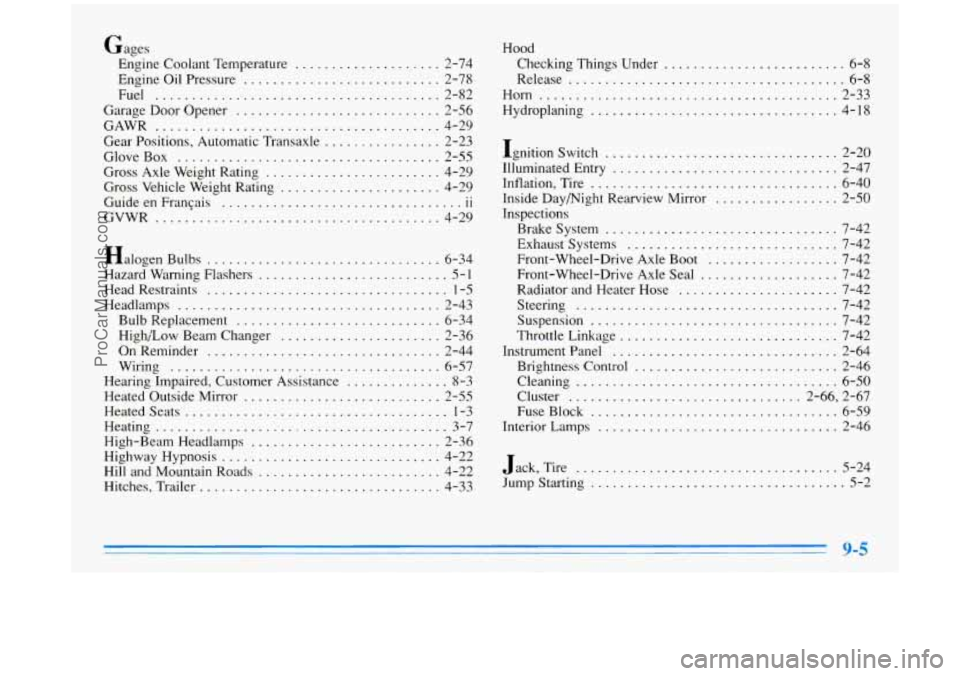
Gages Engine Coolant Temperature
.................... 2-74
Engine Oil Pressure
........................... 2-78
Fuel
....................................... 2-82
Garage Door Opener
............................ 2-56
GAWR
....................................... 4-29
Gear Positions. Automatic Transaxle
................ 2-23
GloveBox
.................................... 2-55
Gross Axle Weight Rating
........................ 4-29
Gross Vehicle Weight Rating
...................... 4-29
Guide en Franqais
11
GVWR ....................................... 4-29
.. .................................
Halogen Bulbs ................................ 6-34
Hazard Warning Flashers
.......................... 5-1
Head Restraints ................................. 1-5
Headlamps
.................................... 2-43
Bulb Replacement
............................ 6-34
High/'Low Beam Changer
...................... 2-36
On Reminder
................................ 2-44
Wiring
..................................... 6-57
Hearing Impaired. Customer Assistance
.............. 8-3
Heated Outside Mirror ........................... 2-55
Heatedseats
.................................... 1-3
Heating
........................................ 3-7
High-Beam Headlamps
.......................... 2-36
Highway Hypnosis
.............................. 4-22
Hill and Mountain Roads
......................... 4-22
Hitches. Trailer
................................. 4-33
Hood
Checking Things Under ......................... 6-8
Release
...................................... 6-8
Horn
......................................... 2-33
Hydroplaning
.................................. 4-18
Ignition Switch
................................ 2-20
Inflation. Tire
.................................. 6-40
Inside Day/Night Rearview Mirror
................. 2-50
Inspections
Brakesystem
................................ 7-42
Exhaust Systems
............................. 7-42
Front-Wheel-Drive Axle Boot
.................. 7-42
Front-Wheel-Drive Axle Seal
................... 7-42
Radiator and Heater Hose
...................... 7-42
Illuminated
Entry
............................... 2-47
Steering
.................................... 7-42
Suspension
.................................. 7-42
Throttle Linkage
......................... ... ... 7-42
Instrument Panel
............................... 2-64
Brightness Control
............................ 2-46
Cluster
................................ 2-66, 2-67
FuseBlock
.................................. 6-59
Interior Lamps
................................. 2-46
Cleaning
.................................... 6-50
Jack. Tire
.................................... 5-24
Jump Starting
................................... 5-2
.
....
ProCarManuals.com
Page 385 of 388
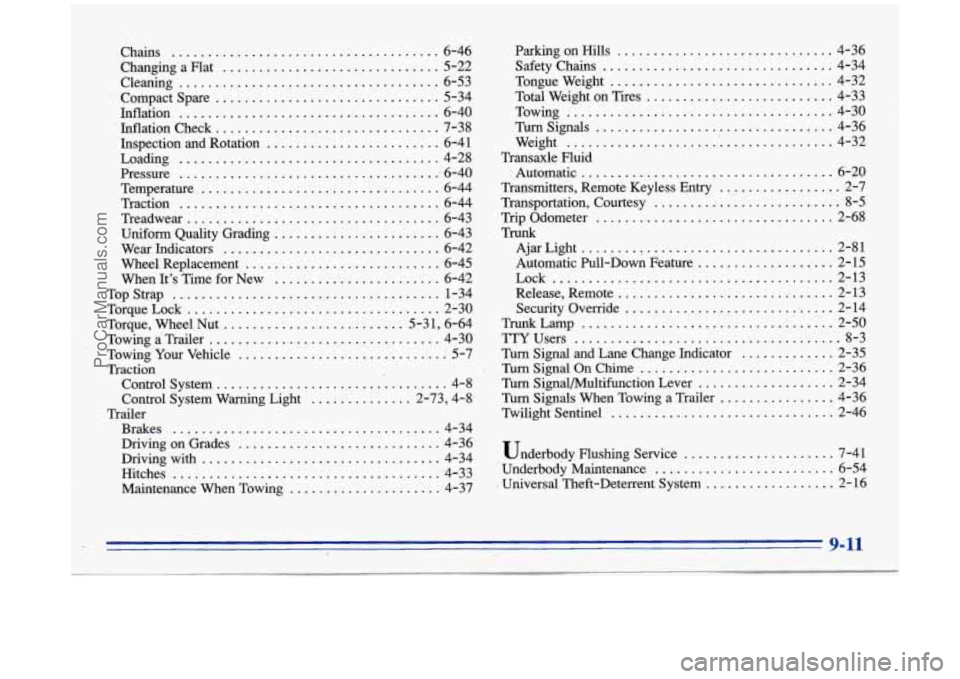
I t.
I 1
Chains ..................................... 6-46
Changing a Flat
.............................. 5-22
Cleaning
.................................... 6-53
. Compact Spare ............................... 5-34
Inflation
.................................... 6-40
. Inflation Check ............................... 7-38
Inspection and Rotation
........................ 6-41
Loading
.................................... 4-28
Pressure
...................................... 6-40
Temperature
................................. 6-44
Traction
.................................... 6-44
Treadwear
.................................... 6-43
Uniform Quality Grading
....................... 6-43
Wear Indicators
............................... 6-42
Wheel Replacement
........................... 6-45
When It's Time for New
....................... 6-42
TorqueLock
.................................... 2-30
Torque, Wheel
Nut ......................... 5-31, 6-64
Towing
8 Trailer ................................ 4-30
Towing Your Vehicle
.............................. 5-7
Traction
Control System
................................ 4-8
Control System Wasrning Light
.............. 2-73, 4-8
Brakes
.'.................................... 4-34
DrivingonGrades
............................ 4-36
Drivingwith
................................. 4-34
Maintenance When Towing
..................... 4-37
TopStrap
...................................... 1-34
Trailer Hitches
..................................... 4-33 Parking
on
Hills .............................. 4-36
Safety Chains
................................ 4-34
Tongueweight
............................... 4-32
Total Weight on Tires
.......................... 4-33
Turnsignals
................................. 4-36
Weight
...................................... 4-32
Transaxle Fluid .Automatic
.........?......................... 6-20
Transmitters, Remote Keyless Entry
................. 2-7
Transportation, Courtesy
........ .I ................. 8-5
Trip Odometer
................................. 2-68
TrUnk AjarLight
................................... 2-81
Automatic Pull-Down Feature
................... 2-15
Release, Remote
.............................. 2-13
Towing
..................................... 4-30
Lock
....................................... 2-13
SecurityOverride
.............................. 2-14
TrUnkLamp
................................... 2-50
TTYUsers
..................................... 8-3
Turn Signal and Lane Change Indicator
............. 2-35
Turn Signal On Chime
........................... 2-36
Turn SignalNultifunction Lever
................... 2-34
Turn Signals When Towing a Trailer
................ 4-36
Twilight Sentinel
............................... 2-46
. underbody Flushing Service ..................... 7-41
Underbody Maintenance
......................... 6-54
l Universal Theft-Deterrent System .................. 2-16
.. ~~ i %ll ..
ProCarManuals.com